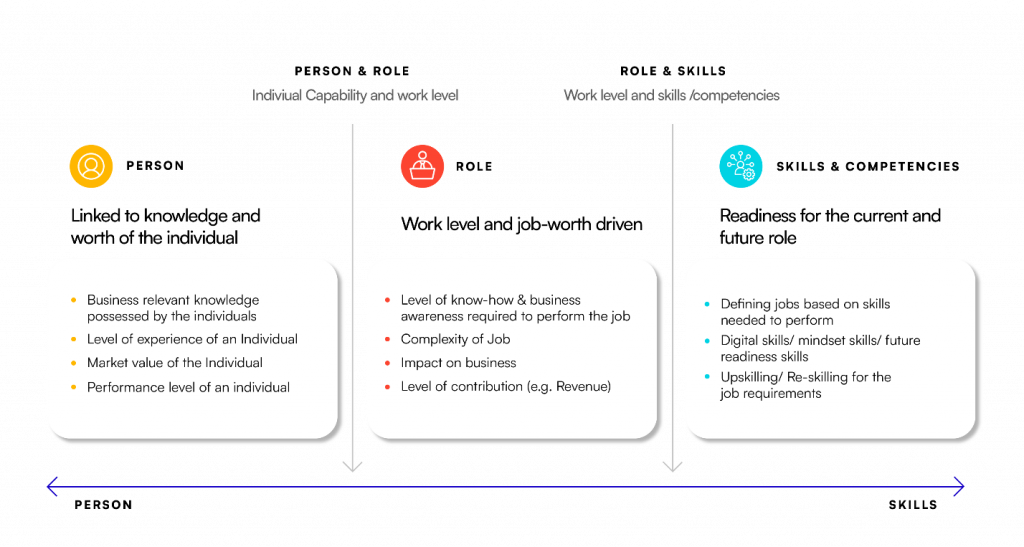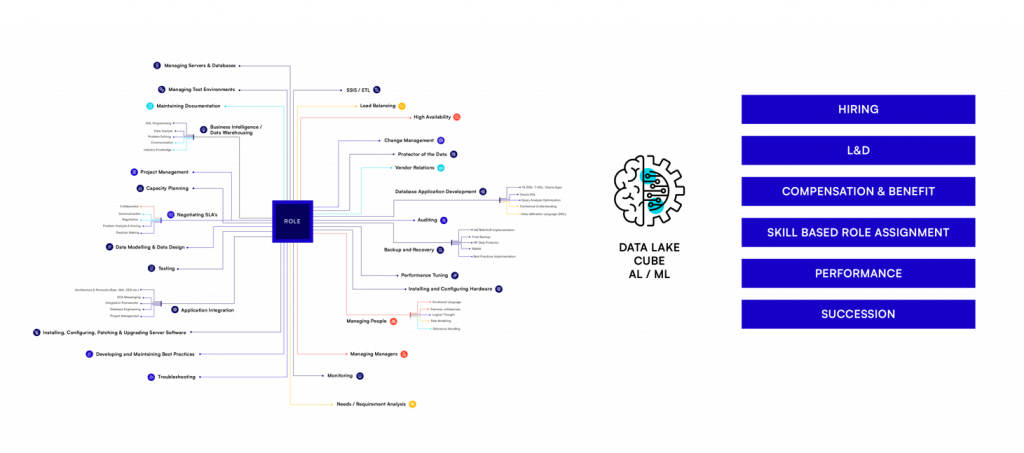The world of work is changing, and it is changing faster than we can imagine. Gartner research found that three-quarters of jobs had more than 40% of their required skills change between 2016 and 2019. And the pace of change is only accelerating post the ChatGPT revolution.
💡 44% of workers’ skills will be disrupted in the next five years (World Economic Forum, Future of Jobs report 2023)
Amidst these shifts, organizations in the Middle East are redefining their talent strategies. Companies are transitioning from a person-based to role-based, and now a skill-based approach to talent management.

This shift towards skills is unsurprising, as it widens the talent pool for dynamic environments. However, it also highlights challenges in designing a skills-based talent strategy.
Skills serve as the foundational element for any robust talent strategy. However, the challenge lies in the absence of readily available skill taxonomy or skill inventories that comprehensively map each job role to the requisite skills for success. Consider an organization with a diverse workforce encompassing 500 distinct roles. Establishing a skill repository for such a scenario demands significant commitment and time investment. Even if such a resource existed, the inherent variations in organizational contexts across different companies would render it ineffective without necessary customizations.
Another major hurdle is integrating skills data from various sources. To get the best analytics and artificial intelligence driven experiences—such as personalized career recommendations—across these applications, data needs to be connected.
The process of integrating skills data is far from simple. It frequently involves intricate complexities, necessitating expensive tailored integrations that don’t consistently yield results. Consequently, organizations often fail to extract the maximum value from their skills-based applications.
The Role of AI in Talent Management
Artificial Intelligence is rapidly emerging as a prominent force in the field of talent management. Recent studies indicate that integration of AI can add up to $150 billion to the economies of countries in the Gulf Cooperation Council (GCC).
To harness the power of AI in their talent strategies, CHROs need to reimagine their approach to skills data. This includes what data they use and how much of it, how they use it to create development opportunities for employees, and what technical and ethical challenges of automation exist.
AI algorithms efficiently process vast data volumes, offering insights impossible to achieve manually. From recruitment to succession planning, AI impacts the talent lifecycle, enhancing decisions based on actionable insights.
- The Skills Lacuna: organizations traditionally lacked a detailed analysis of the capabilities they need to develop when building talent strategies. Artificial intelligence has changed this by simplifying data collection and analysis for skill gap analysis. What used to take 3-6 months can now be done more quickly and accurately.
- Skills-Capability handshake: AI technologies take the skill gap analysis one step further by matching each organizational role with the necessary skills for success. AI learns and suggests the skills an organization should possess, fostering overall capability development and addressing vital questions such as, “Do we have the right people for our organization?”
- Identifying the right people: The skill based match-making capability (Job Description – CV) empowers recruiters to identify candidates with the desired skills, enhancing decision-making with a structured and objective approach.
- Skill-based role assignment: The roles of managers and leaders are evolving from traditional employee management to dynamic orchestration of work and skills within projects, tasks, or problem-solving contexts. In this shift, influence and empowerment take precedence over traditional hierarchical structures.
- Hyper-personalized learning & career paths: Detecting disparities between an employee’s current abilities and the required ones can precisely identify their unique learning and development needs. This, in turn, streamlines their journey for upskilling while also assisting them in exploring various career paths available throughout their professional journey.
- Linking Performance to Business Objectives: AI powered goal libraries recommend goals/OKRs/KPIs basis role, past performance, manager objectives, and company priorities.
- Succession planning: AI can map business critical roles and identify what skills are possessed by the workforce today, what skills are needed in the future – which ones can be built internally, which ones will need to be acquired externally. (Build, Buy or Borrow)
📜 Suggested Read: Succession Planning — A Premium to Insure Business Continuity
- Compensation & Benefits: Considering the market demand for skills, offering a Skills Premium for employees possessing “Hot Skills” (in high demand and low supply) provides an objective method to base compensation on an individual’s specific skill set. This approach ensures that compensation aligns directly with an individual’s bundle of skills.
Companies like PeopleStrong are at the forefront of this AI revolution in talent management across the region. Their AI-powered skills framework has been trained on over 1 million data points and has mapped more than 50,000 roles with skills. It features 15-years of enriched skill data collected from across 20 industries offering functional benefits like predictive data analytics and proactive insights.

Artificial intelligence (AI) has become the buzzword of the decade. After 45 years of research, computer scientists have developed systems that can talk to us; classify photos; create images; and analyze, modify, and author video and audio content. And, as with any new technology, there’s a massive amount of hype, confusion, trepidation, and even fear.
AI and Talent Management in the MENA Region
In the Middle East, the adoption of AI in Talent Management is gaining momentum. Companies are increasingly relying on AI-powered frameworks to map skills to roles. Specialised IT education programs, vocational training, and partnerships with international technology institutions are being implemented to nurture a skilled workforce.
These developments are particularly important as the IT industry in the GCC countries is expected to continue experiencing significant growth, driven by digital transformation, smart city initiatives, cybersecurity, innovation, cloud computing, e-commerce, AI, and robotics.
The Future: Gen AI and User Experience
The advent of Gen AI marks a significant leap in the evolution of artificial intelligence, particularly in enhancing the end-user experience. Unlike its predecessors, Gen AI is designed to be more conversational, intuitive, and user-friendly. Large language models or LLM based tools like ChatGPT & Bard have revolutionized how the experience for end users.
Automation of repetitive tasks and the enhancement of human capabilities by generative AI may lead to more efficient and fulfilling roles for employees. However, it will also replace certain jobs, improve others, and create new ones, such as AI researchers and software engineers. Organizations will have the opportunity to completely rethink their operations and reshape their team structures, focusing more on cross-functional collaboration and agile work models. As famously said by Lareina Yee of McKinsey,
“In some ways, the genie is out of the bottle. It’s probably not the best strategy to try to put it back in. Lean forward and figure out how to use it in a way that’s productive and safe.”












